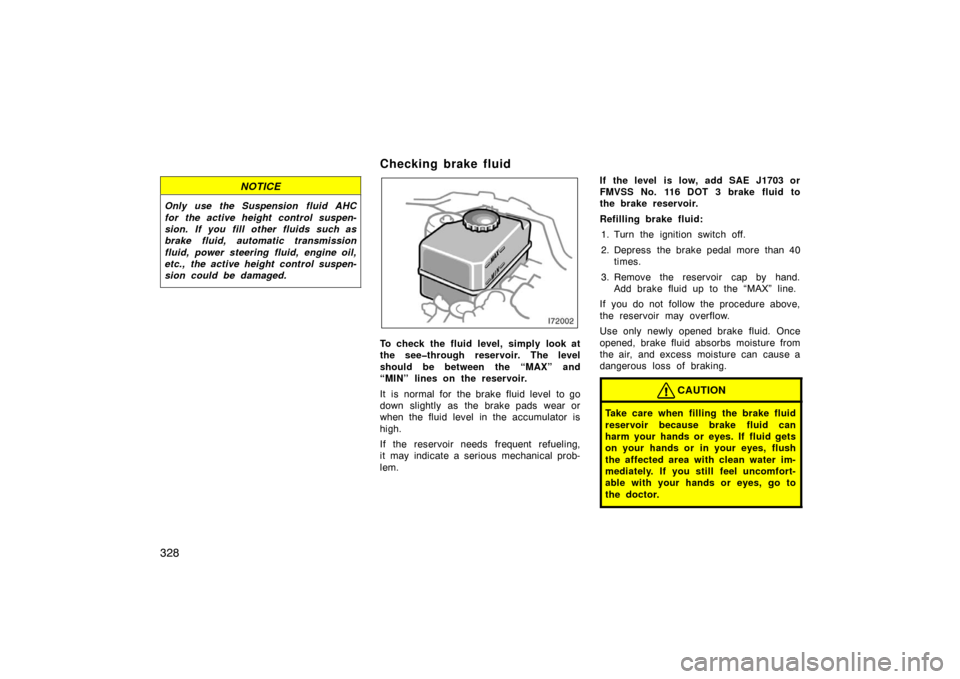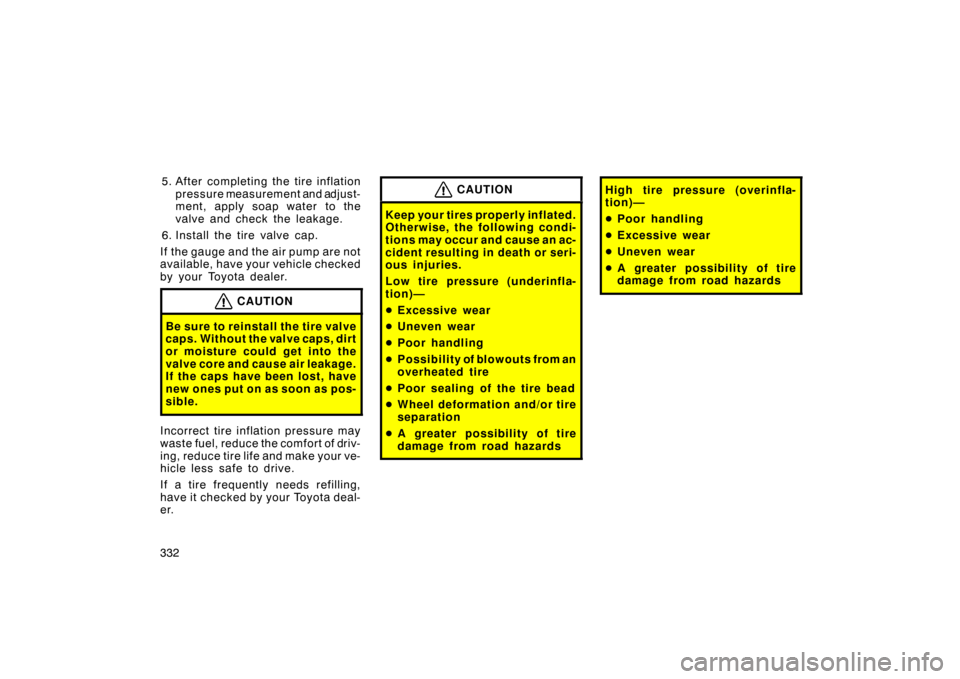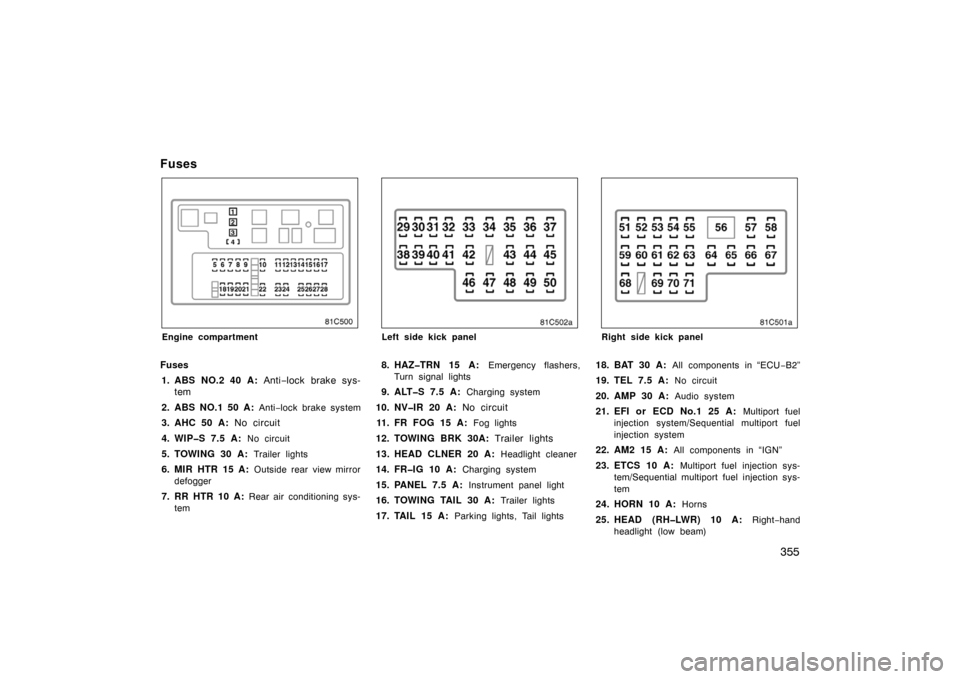Page 334 of 374

320
If you perform maintenance by yourself,
be sure to follow the correct procedure
given in this section.
You should be aware that improper or in-
complete servicing may result in operating
problems.
Performing do−it−yourself maintenance
during the warranty period may affect your
warranty coverage. Read the separate
Toyota Warranty statement for details and
suggestions.
This part gives instructions only for those
items that are relatively easy for an owner
to perform. As explained in Section 6,
there are still a number of items that must
be done by a qualified technician with
special tools.
For information on tools and parts for do −
it −yourself maintenance, see “Parts and
tools” on page 321.
Utmost care should be taken when work-
ing on your vehicle to prevent accidental
injury. Here are a few precautions that
you should be especially careful to ob-
serve:CAUTION
�When the engine is running, keep
hands, clothing, and tools away
from the moving fan and engine
drive belts. (Removing rings,
watches, and ties is advisable.)
�Right after driving, the engine
compartment—the engine, radiator,
exhaust manifold, power steering
fluid reservoir and spark plug
boots, etc.—will be hot. So be care-
ful not to touch them. Oil, fluids
and spark plugs may also be hot.
�If the engine is hot, do not remove
the radiator cap or loosen the drain
plugs to prevent burning yourself.
�Do not leave anything that may
burn easily, such as paper or rags,
in the engine compartment.
�Do not smoke, cause sparks or al-
low open flames around fuel or the
battery. Their fumes are flammable.
�Be extremely cautious when work-
ing on the battery. It contains poi-
sonous and corrosive sulfuric acid.
�Do not get under your vehicle with
just the body jack supporting it. Al-
ways use automotive jack stands or
other solid supports.
�Be sure that the ignition is off if
you work near the electric cooling
fan or radiator grille. With the igni-
tion on, the electric cooling fan will
automatically start to run if the air
conditioning is on.
�Use eye protection whenever you
work on or under your vehicle
where you may be exposed to flying
or falling material, fluid spray, etc.
�Used engine oil contains potentially
harmful contaminants which may
cause skin disorders such as in-
flammation or skin cancer, so care
should be taken to avoid prolonged
and repeated contact with it. To re-
move used engine oil from your
skin, wash thoroughly with soap
and water.
�Do not leave used oil within the
reach of children.
Do�it�yourself service
precautions
Page 339 of 374
325
ENGINE OIL SELECTION
“Toyota Genuine Motor Oil” is used in
your Toyota vehicle. Use Toyota approved
“Toyota Genuine Motor Oil” or equivalent
to satisfy the following grade and viscos-
ity.
Oil grade:ILSAC multigrade engine oil
Recommended viscosity:
SAE 5W −30
Outside temperature
SAE 5W�30 is the best choice for good
fuel economy, and good starting in cold
weather.
If SAE 5W�30 oil is not available, SAE
10W�30 oil may be used. However, it
should be replaced with SAE 5W�30 at
the next oil change.
Oil identification mark
The ILSAC (International Lubricant Stan-
dardization and Approval Committee) Certi-
fication Mark is added to some oil con-
tainers to help you select the oil you
should use.
Page 342 of 374

328
NOTICE
Only use the Suspension fluid AHC
for the active height control suspen-
sion. If you fill other fluids such as
brake fluid, automatic transmission
fluid, power steering fluid, engine oil,
etc., the active height control suspen-
sion could be damaged.
Checking brake fluid
To check the fluid level, simply look at
the see�through reservoir. The level
should be between the “MAX” and
“MIN” lines on the reservoir.
It is normal for the brake fluid level to go
down slightly as the brake pads wear or
when the fluid level in the accumulator is
high.
If the reservoir needs frequent refueling,
it may indicate a serious mechanical prob-
lem.If the level is low, add SAE J1703 or
FMVSS No. 116 DOT 3 brake fluid to
the brake reservoir.
Refilling brake fluid:
1. Turn the ignition switch off.
2. Depress the brake pedal more than 40 times.
3. Remove the reservoir cap by hand. Add brake fluid up to the “MAX” line.
If you do not follow the procedure above,
the reservoir may overflow.
Use only newly opened brake fluid. Once
opened, brake fluid absorbs moisture from
the air, and excess moisture can cause a
dangerous loss of braking.
CAUTION
Take care when filling the brake fluid
reservoir because brake fluid can
harm your hands or eyes. If fluid gets
on your hands or in your eyes, flush
the affected area with clean water im-
mediately. If you still feel uncomfort-
able with your hands or eyes, go to
the doctor.
Page 346 of 374

3325. After completing the tire inflation
pressure measurement and adjust-
ment, apply soap water to the
valve and check the leakage.
6. Install the tire valve cap.
If the gauge and the air pump are not
available, have your vehicle checked
by your Toyota dealer.
CAUTION
Be sure to reinstall the tire valve
caps. Without the valve caps, dirt
or moisture could get into the
valve core and cause air leakage.
If the caps have been lost, have
new ones put on as soon as pos-
sible.
Incorrect tire infl ation pressure may
waste fuel, reduce the comfort of driv-
ing, reduce tire life and make your ve-
hicle less safe to drive.
If a tire frequently needs refilling,
have it checked by your Toyota deal-
er.
CAUTION
Keep your tires properly inflated.
Otherwise, the following condi-
tions may occur and cause an ac-
cident resulting in death or seri-
ous injuries.
Low tire pressure ( underinfla-
tion)—
� Excessive wear
� Uneven wear
� Poor handling
� Possibility of blowouts from an
overheated tire
� Poor sealing of the tire bead
� Wheel deformation and/or tire
separation
� A greater possibility of tire
damage from road hazards
High tire pressure (overinfla-
tion)—
�Poor handling
� Excessive wear
� Uneven wear
� A greater possibility of tire
damage from road hazards
Page 363 of 374
349
SPECIFICATIONS
Specifications
Dimensions and weightss350
. . . . . . . . . . . . . . . . . . . . . . . . . . . . . . . . . . .
Engine 350
. . . . . . . . . . . . . . . . . . . . . . . . . . . . . . . . . . . . \
. . . . . . . . . . . . . . . .
Fuel 350
. . . . . . . . . . . . . . . . . . . . . . . . . . . . . . . . . . . . \
. . . . . . . . . . . . . . . . . . .
Service specifications 351
. . . . . . . . . . . . . . . . . . . . . . . . . . . . . . . . . . . . \
. . .
Tires 354
. . . . . . . . . . . . . . . . . . . . . . . . . . . . . . . . . . . . \
. . . . . . . . . . . . . . . . . .
Fuses 355
. . . . . . . . . . . . . . . . . . . . . . . . . . . . . . . . . . . . \
. . . . . . . . . . . . . . . . .
SECTION 8
Page 364 of 374
350
Dimensions and weights
Overall length mm (in.) 4890 (192.5)
Overall width mm (in.) 1940 (76.4)
Overall height
∗1mm (in.) 1875 (73.8)
1850 (72.8)∗2
Wheelbase mm (in.) 2850 (112.2)
Front tread mm (in.) 1620 (63.8)
Rear tread mm (in.) 1615 (63.6)
Vehicle capacity weight
(occupants + luggage)
kg (lb.) 545 (1200)
Towing capacity
(trailer weight + cargo weight) kg (lb.) 2948 (6500)
∗1: Unladen vehicle
∗2: With active height control suspension
Engine
Model:
4.7L V8 (2UZ −FE)
Type: 8 cylinder V type, 4 cycle, gasoline
Bore and stroke, mm (in.): 94.0 � 84.0 (3.70 � 3.30)
Displacement, cm
3 (cu. in.):
4664 (284.6)
Fuel
Fuel type: Unleaded gasoline, Octane Rating 87
(Research Octane Number 91) or higher.
Fuel tank capacity, L (gal., Imp.gal.): 96 (25.4, 21.1)
Page 369 of 374

355
Fuses
Engine compartment
Fuses1. ABS NO.2 40 A: Anti−lock brake sys-
tem
2. ABS NO.1 50 A:
Anti−lock brake system
3. AHC 50 A: No circuit
4. WIP�S 7.5 A:
No circuit
5. TOWING 30 A: Trailer lights
6. MIR HTR 15 A: Outside rear view mirror
defogger
7. RR HTR 10 A: Rear air conditioning sys-
tem
Left side kick panel
8. HAZ�TRN 15 A: Emergency flashers,
Turn signal lights
9. ALT�S 7.5 A: Charging system
10. NV�IR 20 A: No circuit
11. FR FOG 15 A:
Fog lights
12. TOWING BRK 30A: Trailer lights
13. HEAD CLNER 20 A:
Headlight cleaner
14. FR�IG 10 A: Charging system
15. PANEL 7.5 A: Instrument panel light
16. TOWING TAIL 30 A: Trailer lights
17. TAIL 15 A: Parking lights, Tail lights
Right side kick panel
18. BAT 30 A: All components in “ECU− B2”
19. TEL 7.5 A: No circuit
20. AMP 30 A: Audio system
21. EFI or ECD No.1 25 A: Multiport fuel
injection system/Sequential multiport fuel
injection system
22. AM2 15 A: All components in “IGN”
23. ETCS 10 A: Multiport fuel injection sys-
tem/Sequential multiport fuel injection sys-
tem
24. HORN 10 A: Horns
25. HEAD (RH�LWR) 10 A: Right−hand
headlight (low beam)
Page 370 of 374

356
81C506
Engine compartment
26. HEAD (LH�LWR) 10 A: Left−hand head-
light (low beam)
27. HEAD (RH�UPR) 20 A: Right −hand
headlight (high beam)
28. HEAD (LH�UPR) 20 A: Left −hand head-
light (high beam)
29. PWR OUTLET 15 A: Power outlets
30. CIG 15 A: Cigarette lighter
31. ACC 7.5 A: Instrument panel light
32. AM1 7.5 A: Multiport fuel injection sys-
tem/Sequential multiport fuel injection
system
33. DEFOG 20 A:
Rear window defogger
34. AHC�B 15 A: Active height control sus-
pension (AHC)
35. FUEL HTR 20 A: Fuel heater
36. POWER HTR 7.5 A: Power heater
37. AHC�IG 20 A: Active height control sus-
pension (AHC)
38. EFI or ECD No.2 10 A: Emission con-
trol system
39. GAUGE1 10 A: Gauges and meters
40. ECU�IG1 10 A: Multiport fuel injection
system/S equential multiport fuel injec-
tion system
41. ECU�B1 10 A:
Navigation system
42. DBL LOCK 15 A: Double lock system
43. A/C 15 A: Air conditioning system
44. STOP 15 A: Stop lights
45. OBD�2 7.5 A: On −board diagnosis sys-
tem
46. IDEL UP 7.5 A: Idle −up system
47. LH SEAT 30 A: Power seat system
48. DOOR 25 A: Power door lock system,
Power windows
49. SUN ROOF 25 A: Electronic moon roof
50. RR WIPER 15 A: Rear wiper system
51.ECU�B2 10 A: Power door lock system,
Power window
52. DIFF 20 A: Four−wheel drive system
53. WASHER 15 A: Windshield washer
54. RADIO 10 A: Audio system
55. DOME 10 A: Interior lights
56. VGRS 40 A: Variable gear ratio steer-
ing system
57. P/W (FL) 20 A: Power window
58. P/W (RL) 20 A: Power window
59. WIPER 25 A: Windshield wiper
60. ECU�IG2 10 A: Rear air conditioning
system
61. SEAT HTR 15 A: Seat heater
62. GAUGE2 10 A: Back−up lights
63. MET 7.5 A: Gauges and meters
64. IGN 7.5 A: Multiport fuel injection sys-
tem/Sequential multiport fuel injection
system
65. SECURITY 7.5 A: Theft deterrent sys-
tem
66. P/W (RR) 20 A: Power window
67. P/W (FR) 20 A: Power window
68. BATT CHARGE 30 A: Trailer charging
system
69. TIL&TEL 20 A: Tilt and telescopic
steering